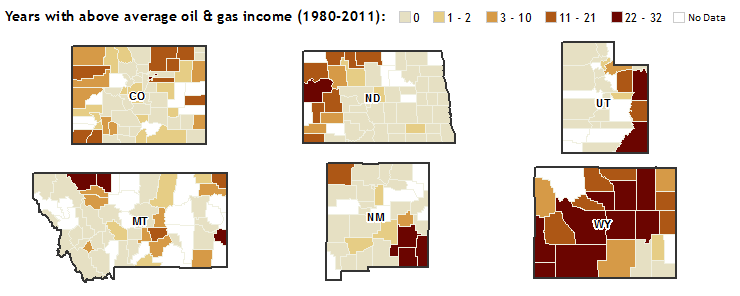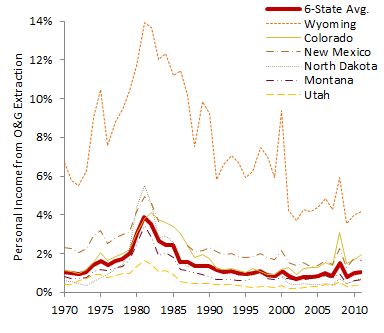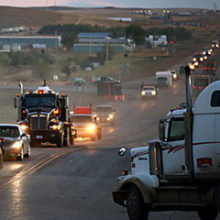Prolonged oil and natural gas specialization leads to lower per capita income, more crime, and less educational attainment
The study reviews the period 1980 to 2011, analyzing the effect of participation in the early 1980s energy boom and the length of time that counties remained specialized in oil and gas. The boom period of 1980-1982 was selected because it contained the highest share of personal income from oil and gas for each of the six major oil- and gas-producing states in the U.S. West: Colorado, Montana, New Mexico, North Dakota, Utah, and Wyoming.
Oil and gas activity can have a strong immediate positive impact on employment and income. Our analysis, however, finds that when fossil fuel development plays a role in a local economy for a long period of time there are negative effects on per capita income, crime rates, and educational attainment.
General Findings
We evaluated the effect of participation in the early 1980s boom and the length of time that counties remained specialized in oil and gas on socioeconomic outcomes in counties within six leading oil and gas producing states of the U.S. West.
- For counties that participated in the early 1980s oil and gas boom, per capita income declines with longer specialization.
- The longer the duration of oil and gas specialization, the higher the crime rate.
- For counties that participated in the early 1980s oil and gas boom, educational attainment declines with longer specialization.
See the Discussion section below for a lengthier analysis. These findings contribute to a broader public dialogue about the consequences of resource specialization involving oil and natural gas and call into question the assumption that long-term oil and gas development confers economic advantages upon host communities.
Figure 1. Share of Personal Income from Oil and Gas Extraction, 1970-2011
Study, Methods, and Citation
The full study (PDF) found that long-term oil and gas specialization has negative effects on per capita income, crime rate, and education rate. Participation in the early 1980s boom was positively associated with change in per capita income; however the positive effect decreases the longer counties remain specialized in oil and gas. The manuscript has a complete discussion of methods, and it should be cited as Haggerty, J., P.H. Gude, M. Delorey, and R. Rasker. In Press. Long-term effects of income specialization in oil and gas extraction: the U.S. West, 1980-2011. Energy Economics.
Discussion
Recently, oil and gas development has been a source of jobs in a challenging economic period, but oil and gas drilling is not without its challenges for local areas. Residents of areas that host energy development often welcome the immediate employment associated with oil and gas development, and at the same time wonder about long-term tradeoffs related to the risk of negative impacts to local environmental amenities and quality of life, along with the direct economic risks of an eventual downturn. Understanding and managing these tradeoffs for long-term community prosperity is a common goal for most communities.
The study analyzed the effect of participation in the early 1980s boom and the length of time that counties remained specialized in oil and gas. The boom period of 1980-1982 was selected because it contained the highest share of personal income from oil and gas for each of the six study states. We evaluated how socioeconomic outcomes varied with both the percent of personal income from oil and gas extraction from 1980 to 1982 and the count of years, from 1980 to 2011, in which the percent of personal income from oil and gas extraction was above the annual average for the sample counties.
On average, counties that participated in the early 1980s boom experienced greater declines in socioeconomic performance with each year in which oil and gas income was above average. These effects included declines in per capita income and education attainment and increases in crime rates. Similarly, the positive effect of participation in the early 1980s boom on change in per capita income decreases the longer counties remain specialized on oil and gas.
The study reviews the relationships between oil and natural gas specialization and socioeconomic well-being during the period 1980 to 2011 in a large sample of 207 of 258 counties (51 counties were dropped due to a lack of available economic data) within the six major oil- and natural gas-producing states in the interior U.S. West: Colorado, Montana, New Mexico, North Dakota, Utah, and Wyoming.
This geographically contiguous cohort of states has hosted multiple episodes of significant oil and/or natural gas development activities, including high levels of participation in the oil and gas activity buildup during the energy boom of the late 1970s and early 1980s. Taken together, the latest available rankings show that this group of states produces more than 75 percent of crude oil and more than 95 percent of natural gas in the contiguous West.
Counties offer the best scale of analysis because they are the smallest geographic unit for which long-term data on a variety of economic and social metrics are available. The county sample included some with no reliance on oil and gas development, others where oil and gas production has been the dominant economic sector, and others where oil and gas development has occurred within a diverse economy.
Figure 2. Durations of Above Average Oil and Gas Income, 1980-2011
Greater specialization in oil and gas over the long term leads to diminished per capita income.
For counties with high participation during the 1980-82 boom, per capita income during the period 1980-2011 decreases for counties with longer above average income from oil and gas. The magnitude of this relationship is substantial, decreasing per capita income by as much as $7,000 for a county with high participation in the boom (greater than 8% of income from oil and gas) and long-term specialization (greater than 10 years) versus an identical county with only one year of specialization in oil and gas.
We also found that the shorter amount of time that a county specialized in oil and gas development, the more positive the relationship between participation in the boom and per capita income growth. So a county that participated in the 1980-82 boom, for example, but saw energy decrease in importance shortly thereafter, has a better chance of retaining its growth in per capita income. This suggests that continued exposure to above average levels of oil and gas activity lowers per capita income growth, such that initial income gains erode and may eventually become negative.
Growth in the oil and gas sector is associated with higher crime rates.
In addition to income effects, the study finds that the longer a county has been specialized on oil and gas, the higher the county’s crime rate. The magnitude of this relationship is modest, increasing the crime rate by up to 50 violent and property crimes, for example, in counties that have a population of 20,000, high initial participation in the boom (greater than 8% of income from oil and gas), and long-term specialization (greater than 10 years) compared to a similar county with only one year of above average income from oil and gas.
Growth in the oil and gas sector is associated with declining educational attainment.
For counties with high participation during the 1980-82 boom (greater than 8% of income from oil and gas), the percent of adults with a college education decreases the longer the county stays specialized on oil and gas. The magnitude of this relationship is large, with as many as 2.5 percent fewer adults with college degrees in a county with high participation in the boom and consistent, long term specialization (greater than 10 years) versus an identical county with only one year of specialization in oil and gas. The education effect may be a predictable outcome of specialization in a workforce that traditionally has had low education requirements, but it does raise questions about the competitiveness of the local economy during periods when the energy development sector is not active.
These findings are consistent with other research that shows diminished socioeconomic benefit of resource extraction at the local level over time. The findings also support the theory that a resource curse has affected local areas that are specialized in oil and gas in the six energy-producing states in the U.S. West.







